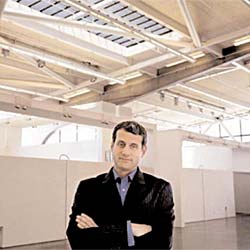 Joseph Rosa has a lot on his mind. The Art Institute of Chicago’s newly named John H. Bryan Curator of Architecture and Design is in the midst of selling his Oakland, California, home of nearly four years, packing some 88 boxes of books, and flying to Chicago to close on the Lake View flat where he and his family will take residence just a month before his September 15th starting date at the museum. “We saw 35 houses in four days,” he says about the frenetic logistics of this latest career move. But given the chance to spearhead the Art Institute’s mission to build a pre-eminent museum department of architecture and design-one to rival the program at New York City’s Museum of Modern Art-Rosa figures the effort is worth it.
Joseph Rosa has a lot on his mind. The Art Institute of Chicago’s newly named John H. Bryan Curator of Architecture and Design is in the midst of selling his Oakland, California, home of nearly four years, packing some 88 boxes of books, and flying to Chicago to close on the Lake View flat where he and his family will take residence just a month before his September 15th starting date at the museum. “We saw 35 houses in four days,” he says about the frenetic logistics of this latest career move. But given the chance to spearhead the Art Institute’s mission to build a pre-eminent museum department of architecture and design-one to rival the program at New York City’s Museum of Modern Art-Rosa figures the effort is worth it.
In 2009, the Art Institute will unveil its $258-million expansion by the Pritzker Prize–winning architect Renzo Piano. The new wing, some 264,000 square feet of additional display area, will house mainly the museum’s impressive collection of modern works from architecture, furniture, and decorative arts to its serious cache of paintings, which includes the world’s foremost collection of surrealism. And as many scholarly institutions are paying increased attention to architecture and design, the museum astutely decided to beef up its already considerable holdings in those areas.
That foresight resulted in Rosa’s appointment, the first by James Cuno, who was installed as the Art Institute’s president and director just a year ago. “Chicago is a fantastic city with an amazing historical legacy, yet poised with so much young talent,” says Rosa, 45, who arrives after leaving his post as curator of architecture and design at the San Francisco Museum of Modern Art. “It’s a rare situation that those three elements align so brilliantly. Given that framework, how could I not want to come to Chicago?”
A Columbia University–educated scholar, Rosa believes looking at art is a visceral experience and gut reactions are key. “You have to circumnavigate what people might bring to the table,” he says. “You get them interested in the subject matter and then tell them more about what they want to know.” The museum also plans to hire a curator of design, whom Rosa will choose, and along with a handful of other positions, the appointment will make the Chicago department’s curatorial team one of the largest in the country.
With construction having begun on the new wing, however, Rosa’s focus is on the collection. He plans to devise an encyclopedic installation of objects-similar to the museum’s visual art holdings, but with a focus on the 20th century-that will be on permanent view. The pieces to be garnered include everything from archival documents such as drawings and blueprints to actual building fragments and substantial examples of modern design, such as furniture and home accessories.
“Collecting [objects] is a way of seeing things,” explains the scholar. But the enthusiast can’t be contained. “Being given this opportunity is like being a kid in a candy store.”


